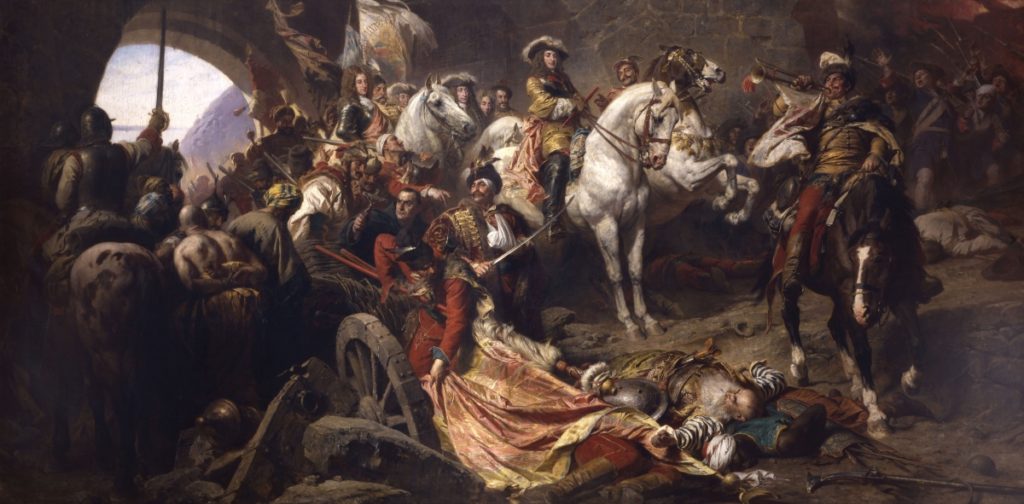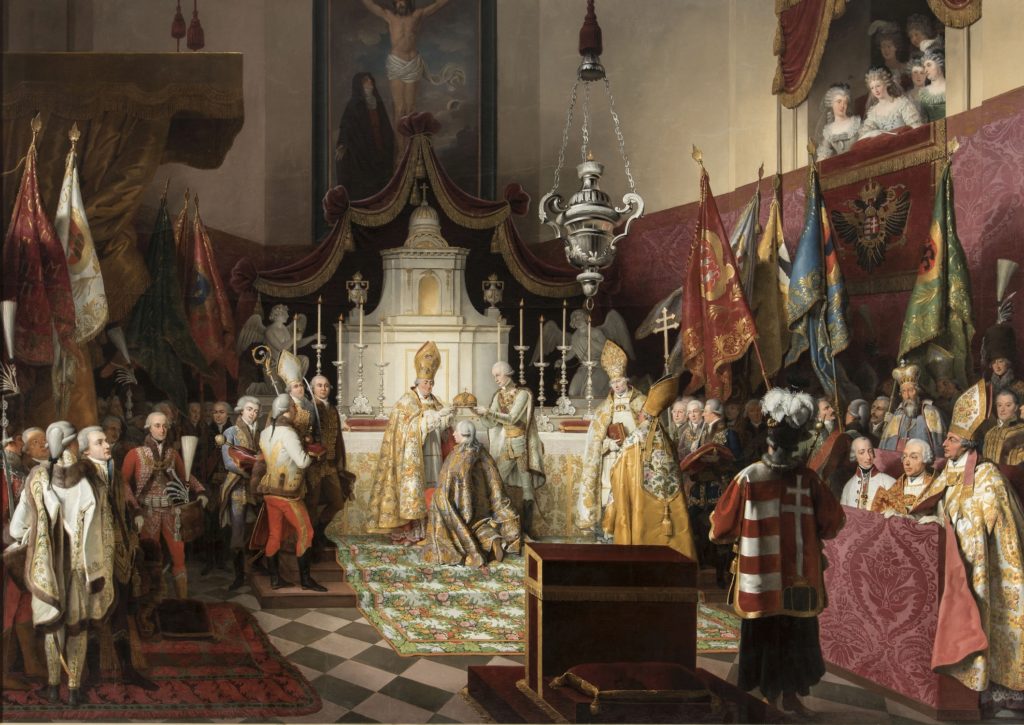We use cookies to provide you with the best possible service and a user-friendly website.
Please find our Privacy Policy on data protection and data management here
Please find more information on the cookies here
Hungarian ceremonial dress

We want to invite you to join us on a journey of the imagination and celebrate the national holiday of 15 March together as we look at some beautiful Hungarian attire.
Stations
- Gyula Benczúr, The Recapture of Buda Castle, 1896
- Peter Krafft, The Coronation of Francis I, 1825 – the coronation mantle of Saint Stephen
- Peter Krafft, The Coronation of Francis I, 1825 – ceremonial dress of Archduke Alexander Leopold
- Peter Krafft, The Coronation of Francis I, 1825 – the guard uniform of Antal Esterházy
- Peter Krafft, Palatine Joseph in Hussar Uniform, 1820
Gyula Benczúr, The Recapture of Buda Castle, 1896

Buda Castle was recaptured from the Turks by a combined force of Hungarians and other European units in the summer of 1686. Benczúr immortalised the heroes of the siege in this painting depicting them in splendid attire. One of the central figures is Dávid Petneházy with his arm in a sling and his head bandaged. The most pronounced element of Petneházy’s clothing is the richly embroidered pelisse (mente) made out of red silk. Under the fur-lined outer coat, you can see a fitted jacket (dolmány) cut to the waist and its somewhat longer right lap transversely overlapping with the left one. The fur-trimmed hat is adorned with a plume and a gemstone. These elements of the ensemble appeared in Hungarian traditional attire later on, in the 19th- and 20th centuries.
We can see the same overlapping cut on the fitted jacket of the valiant soldier (vitéz) holding two flags and positioned before Petneházy.

Peter Krafft, The Coronation of Francis I, 1825 – the coronation mantle of Saint Stephen

Francis I succeeded his father, Leopold II, to the Hungarian throne in 1792. The venue of the coronation was the then Church of Mary Magdalene (later renamed the Garrison Church). The most prominent element of Francis’s clothing is his coronation mantle. This richly embroidered silk mantle was originally a chasuble, which was gifted to the Church of the Virgin Mary in Székesfehérvár by Saint Stephen and his wife, Gisela, in 1031. It was altered sometime in the 13th century, when the collar was added to it. Andrew III was the first king to be crowned in this mantle in 1290.

Peter Krafft, The Coronation of Francis I, 1825 – ceremonial dress of Archduke Alexander Leopold

The crown is placed on a kneeling Francis’s head by Prince-primate József Batthyány, the bishop of Esztergom, and Archduke Alexander Leopold, the palatine of Hungary (the king’s younger brother). The archduke’s silk Hungarian ceremonial dress is especially elegant. The trousers, the fitted jacket and the fur lined cloak thrown over the shoulder are made out of the same cross-striped turquoise silk. The front of the fitted jacket is cut transversely and a belt made up of five bundles of braids decorates the palatine’s waist. The soutache belts were made out of the same material as the braids that decorated the clothes. The belts were fastened with buttons and loops at the back.
Peter Krafft, The Coronation of Francis I, 1825 – the guard uniform of Antal Esterházy

The high clergy and aristocracy taking part in the crowning ceremony wore their most beautiful clothes for the occasion. The main figure on the left edge of the picture is Prince Antal Esterházy, who was the captain of the royal guard between 1791 and 1794. The prince’s bodyguard wears a uniform adorned with silver soutache and made up of red trousers, a red fitted jacket and a red pelisse lined with fox fur. He is wearing a waist braided belt with the same colour as the soutache. The mitre in his hand is adorned with an aigrette feather. His fur-lined cloak has a more modern cut and has no buttons at the front.
Peter Krafft, Palatine Joseph in Hussar Uniform, 1820

The painter depicted Palatine Joseph, the younger brother of King Francis, in the uniform of a hussar general. The ceremonial dress of Hussar generals first appeared in the mid-18th century. The three main pieces of the uniform richly adorned with gold braids were the tight red trousers, the short, fitted red jacket cut to the waist and the white fur-lined pelisse. The white colour of the pelisse thrown over the palatine’s shoulder is almost completely covered by the rich braiding. The attire is complemented by a braided belt made of the same material as the golden soutaches. The belts were buttoned at the back to ensure a perfect aesthetic effect of the ensemble. Another accessory of the general’s ceremonial dress was a tall fur hat with a red flap and a plume with a gemstone and an aigrette feather at the front.


